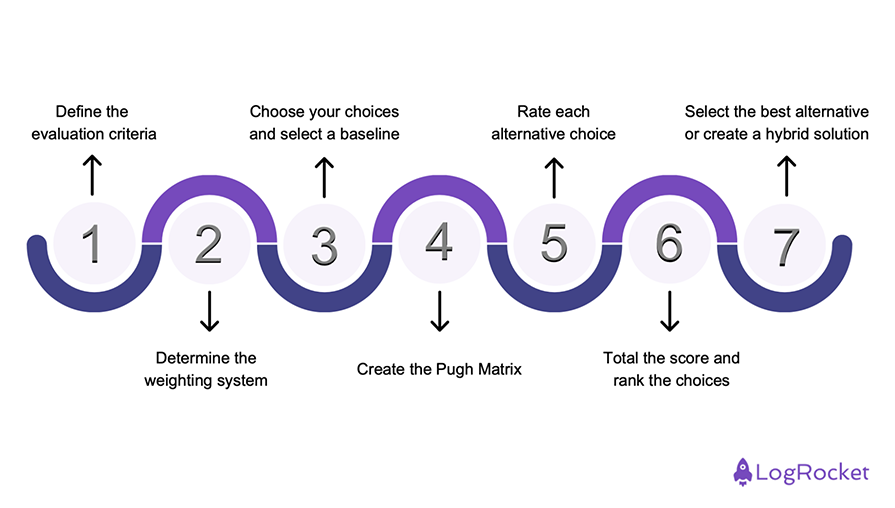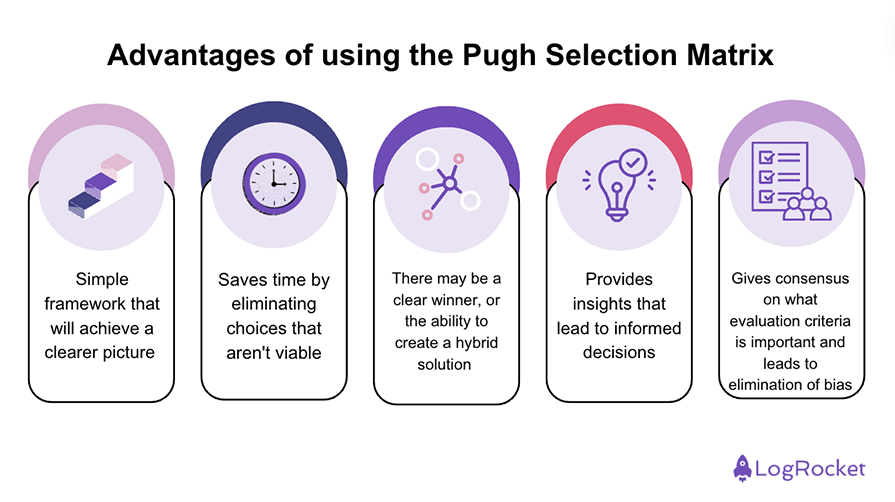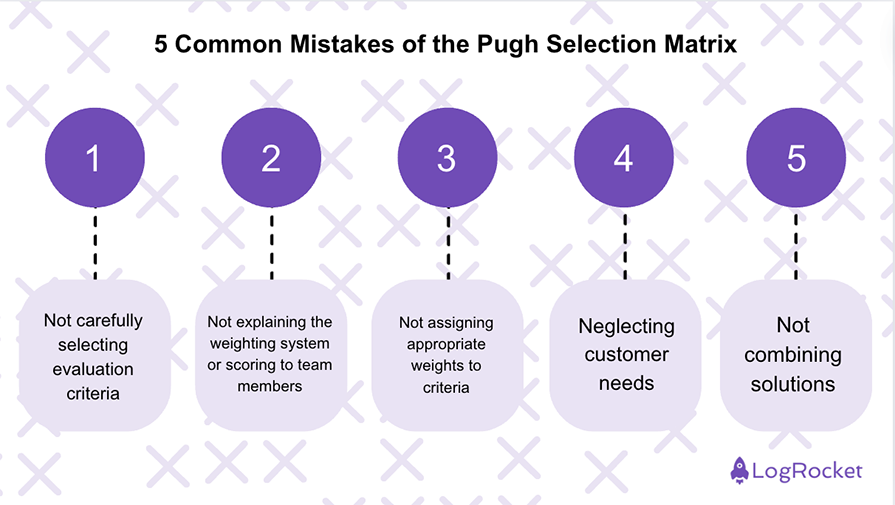The Pugh Matrix is a decision-making tool that is a standard part of many product management methodologies. It’s used to aid in selecting the best solution out of multiple options and is useful for decisions involving several factors and competing opinions.

The Pugh Matrix works by selecting relevant criteria and applying a consistent scoring process. It’s an objective way to compare solutions. The results can lead organizations to making informed decisions for their business.
In this article, we’ll talk about what the Pugh Matrix is, how to create one, and common mistakes to avoid when using one.
The Pugh Selection Matrix is a decision-making framework to compare multiple choices. It begins by determining the qualities of your ideal solution. Then, you select a baseline and compare your alternative choices against it. Once you have tallied up the score, you may find that one or two options are more suitable than the others.
The Pugh Matrix is often used as part of the Six Sigma methodology, specifically in the define phase of the DMAIC process. It’s also useful for DFSS to determine a design concept.
Creating a Pugh Matrix involves a lot of work, but the matrix itself is simple. Let’s dive into the step-by-step process to design an effective Pugh Matrix:

List all the criteria that you would like options to satisfy. It may be helpful to conduct a voice of the customer (VOC) to determine what the customer considers critical to their needs. Some choices for your evaluation criteria can include:
Regardless of what you choose, the criteria should be specific and measurable to make it easy to score.
Creating a weighting system is an optional step, but it has its benefits. Sometimes, some evaluation criteria are more important than others. For example, you may consider regulatory requirements more essential than staying under budget. In this case, a weighting system can provide more accurate scores that align with your values.
To determine the weighting system, you’ll need to use a numeric scale or relative percentage. Then, you’ll rank your choices by relative importance. Be sure to share this weighting system with your team so everyone is on the same page about what is considered important.
Next, identify your possible solutions and alternatives. For an effective Pugh Matrix, you’ll want to list all alternatives. Don’t forget to include existing solutions and custom-built choices. This helps ensure you compare all possible alternatives to find the winning solution.
You’ll also want to choose a baseline for comparison. It’s most likely your current solution, but you can also choose any of the alternatives. All comparisons are relative, so it’s not that important which alternative you choose to be the baseline.
Assemble the Pugh Matrix. Begin by listing all of your evaluation criteria in the left column. The next column is your baseline and the following columns are your possible alternatives. The last column contains the weighting system, if you choose to have one. The last couple of rows will add up your scores and give you a total score and a ranking.
Once you have the Pugh Matrix set up, then you can begin scoring each alternative choice. Possible score options look like this:
Some matrices add a small numbered scoring system for better specification. For example, instead of just a positive symbol, it may say “+1” for slightly better than the baseline or “+2” for much better than the baseline.
After scoring all alternatives with the evaluation criteria, you can tally up the score. If you use the weighting system, then you will need to multiply the criteria score with the relevant weighting system before you sum up the equation.
For example, perhaps you put a 5 for the weighting system for safety. If your alternative was negative, then your score is -5. You can then add the -5 with the rest of the evaluation criteria score. Remember, these are relative scores that don’t represent absolute value. The number is just used for comparison purposes.
When you have a total score for all alternatives, then you can rank the choices from highest to lowest scoring.
The Pugh Selection Matrix may have a clear winner. But sometimes the second or third options are closely behind. You’ll want to evaluate the matrix to see if you can create the best of both worlds. A hybrid solution may reveal itself when you examine the scores. You may want to add this hybrid idea to the Pugh Matrix to see if it scores on top.
Trying to find the best idea is often a tiresome task, especially when there are competing opinions between stakeholders. Using a framework like the Pugh Selection Matrix can help you narrow down your choices into what would provide the most value.
Here are a few of the main benefits of the Pugh Selection Matrix:

While the Pugh Matrix is designed to be straightforward to use, errors can lead to inefficient results. You can avoid this scenario by taking proactive steps to avoid issues. Here are a few common mistakes to look out for when creating a Pugh Matrix:

Make sure you are choosing only a select few relevant criteria. Too many criteria or irrelevant criteria can lead to skewed results. It can be helpful to remember the Pugh Matrix isn’t a final detailed analysis. Instead, it’s a helpful elimination process.
Define what is considered a plus, minus, or the same as the baseline. This ensures stakeholders are consistently applying the scoring system when evaluating the criteria. You’ll also want to share the weighting system and why some criteria are deemed more important than others.
When using a weighting system, you’ll want to ensure that the weights align with the importance of the criteria. Over or under-exaggerating criteria can affect the efficiency of the Pugh Matrix.
You need to find a solution that meets the needs of your customers. But if you don’t find out their requirements, then you can’t build a solution that satisfies them. That’s why it’s highly important to conduct a VOC or other market research to understand what customers desire.
Sometimes new ideas come to you when you evaluate the Pugh Matrix like making a hybrid solution. This can help combine the benefits of multiple solutions.
Avoiding these common pitfalls can help avoid errors and create an insightful Pugh Matrix. The results can lead to data-informed decisions and create better solutions.
The Pugh Matrix’s structured approach makes it easier to compare multiple choices. It helps eliminate bias and focuses on solutions that actually fix the problem at hand. Product managers can discover the best solution with the Pugh Matrix. It’s a valuable tool for the decision-making process, no matter how complicated.

LogRocket identifies friction points in the user experience so you can make informed decisions about product and design changes that must happen to hit your goals.
With LogRocket, you can understand the scope of the issues affecting your product and prioritize the changes that need to be made. LogRocket simplifies workflows by allowing Engineering, Product, UX, and Design teams to work from the same data as you, eliminating any confusion about what needs to be done.
Get your teams on the same page — try LogRocket today.

Most teams fail at autonomy. Learn how clear rules help product teams move faster without micromanagement.

A practical framework for PMs to use AI in ideation without sacrificing judgment, strategy, or decision quality.

A practical five minute revenue estimation method to help product managers compare ideas, drop low impact features, and prioritize smarter.

A practical guide for PMs who want to stop being bottlenecks, delegate smarter, and lead teams effectively with a clear ownership framework.